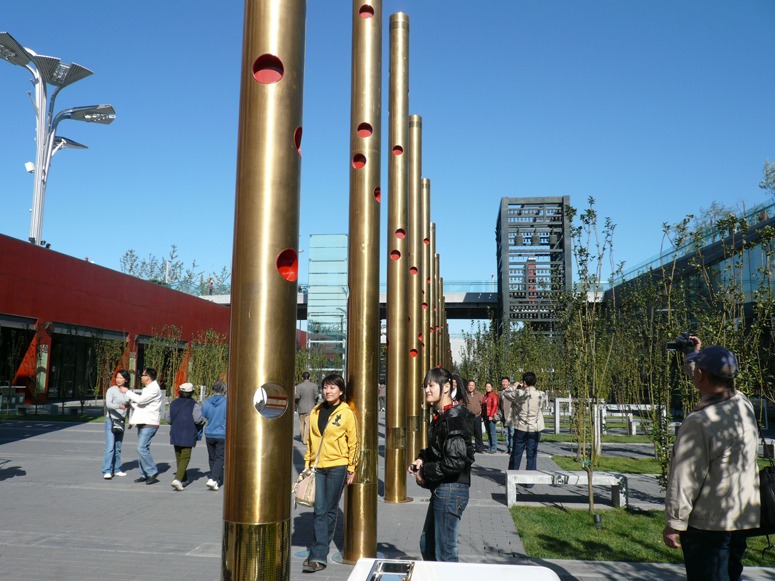I attended a talk today by an Australian landscape architect who graduated in the UK 21 years ago. She now works for an Australian design company engaged in remote landscape design services, primarily conceptual design, for projects in Hong Kong and mainland China (including Chengdu and Beijing). The conceptual design was done in Australia and the detailed design in the Philippines. Then the drawings were sent to China and then translated. It is an amazingly global operation but in my opinion it could be the beginning of a tragedy. The styles used are a mix of ideas from Europe and America, which will make the appearance of China more like that of the west. There is a saying in the west which I like: ‘think global, act local’. I was sorry that the landscape architect had not visited mainland China and hope she will come one day to find out how more about Chinese culture.
This is not a special problem caused by some specific people but the whole system such as the market , economy and something else, and therefore will not be solved quickly. But there are signs of a solution and Mr Yu Kongjian has made reference to “the rediscovery of Chinese cultural identity” problem. With its economic development, China is losing touch with five millennia of ancient identity. The Chinese classical garden is one of the world’s great garden making traditions. In China we are faced with developing a new tradition and a new style. It can be based on historic culture, natural topography and environmental studies of localization and contextualization issues. There are needs to develop China’s landscape education, landscape theory and landscape practice – with a historical perspective, cultural continuity and a perspective on the future of China’s landscape.
国外学习心得——有感于中国景观的发展
今天景观评价及设计课程讲座,演讲者是澳大利亚一位景观师,21年前毕业于这所大学,现是澳大利亚某设计公司创始合伙人,从事远程服务,主要是概念设计。演讲内容是介绍其从业实践,她设计的项目主要是中国香港和内陆如成都、北京等地的多个设计项目。她自己在澳大利亚办公室工作,项目运作的方式是:国内公司提供资料,传到澳大利亚进行概念设计,再传到菲利宾快速出进行详图设计,返回澳大利亚修改确认,最后传到中国翻译形成最终设计成果。
别以为这是令人惊羡的全球化公司运作方式,在我看来是一种悲剧的开始:中国正在大量生产这类没有文化的景观,并且被房地产促销宣传。这类作品要么是法国的、美国的、英国的或者是西方某种混合的风格,但决不是中国的。就是这种西方混合风格的景观作品在中国大行其道,并且被赋予崇洋色彩,这就是中国的城市景观越来越接近西方的原因,而且中国景观规划设计没有规范、标准,西方设计很容易进入。
在西方,文化的态度是:本土的就是世界的,他们think global, act local(站在全球的角度去思考,站在本土的角度去行动)。 可这样的事情在中国却大量的发生着,因为中国市场需要。老实说,我是带着愤慨的心情听完讲座的,尽管她明明切中了中国目前的实情。我说,我非常遗憾听到这些,希望她有一天能够来中国,了解中国文化,设计更有中国文化的作品。
这不是某个人的问题,也不是短时间就能解决的问题,而是我们的整个国家要改善的一些事情。置身国外,深刻体会到俞孔坚先生提到的“重新找回中国文化身份”问题。中国社会经济曾经落后了,也丢失了其具有5千年文化绵延的古国的身份,现在经济发展了,虽然很难说在本世纪能够进入发达国家,但是,我们这一代,确实到了该考虑中国文化的时候了,尤其是考虑中国文化在世界的传播。
中国古典园林是世界三大园林体系之一,在园林史上占举足轻重的地位,但是据我了解,在英国介绍中国古典园林的书远没有介绍日本的多,英国园林受中国影响远没有日本的大。我的导师——一位非常热衷于中国文化的学者,正在出版一本亚洲园林的书,他认为中国是亚洲的中心,并提到作为一位园林史的研究者,不了解中国园林,是一件非常遗憾的事。但中国古典园林代表的时代已经过去,我们现在面对的是中国急需的市场,对西方引入的景观专业,结合中国历史文化、自然地理环境研究其本土化的问题,尽快出台相应的行业标准、规范甚至是法律、法规,促使中国景观教育、景观理论、景观实践并行发展。站在世界文化的高度思考中国园林、历史文化的延续,更为重要的是创造中国景观的未来。

